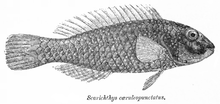Marbled parrotfish
The marbled parrotfish (Leptoscarus vaigiensis), also known as the seagrass parrotfish, is a species of marine ray-finned fish, a parrotfish from the family Scaridae and it is the only known member of the genus Leptoscarus. It has a wide Indo-Pacific distribution and is also found in the south eastern Atlantic Ocean. It is a coastal species found in beds of sea grass and seaweed.
| Marbled parrotfish | |
|---|---|
_et_femelles.jpg) | |
| males | |
| Scientific classification | |
| Kingdom: | Animalia |
| Phylum: | Chordata |
| Class: | Actinopterygii |
| Order: | Labriformes |
| Family: | Scaridae |
| Genus: | Leptoscarus Swainson, 1839 |
| Species: | L. vaigiensis |
| Binomial name | |
| Leptoscarus vaigiensis | |
| Synonyms[2] | |
| |
Description
The Marbled Parrotfish is brown to green with darker mottling on the back fading to yellow or greenish ventrally. The males are marked with a pale longitudinal strip along their flanks and the head, body, dorsal fin and anal fin are marked with small blue spots. The females are mottled brown and white.[3] On the head the females have broad bands which radiate from the eyes.[4] This species has 9 spines and 10 fodt rays in the dorsal fin while the anal fin has 3 spines and 9 soft rays and there are 13 rays in the pectoral fin. The distinctive narrow dental plates, are fuse into a parrot-like beak and are covered in mumerous small teeth.>ref name = Fishbase/> When the its mouth is closed the upper jaw teeth are enclosed by the lower jaw.[3] This species can attain a maximum total length of 35 centimetres (14 in).[2]
Distribution
The marbled parrotfish has a wide Indo-Pacific distribution from the northern Red Sea south along the eastern coast of Africa to the Cape of Good Hope and eastwards through the Indian Ocean and Pacific Ocean to Easter Island. In the Pacific Ocean its range extends north to Japan and south to Rottnest Island off Western Australia and the Poor Knights Islands of New Zealand.[2] In the south eastern Atlantic this species isfound in False Bay in the Western Cape, South Africa.[1] Its distribution is largely anti-equatorial (i.e., found in both the Southern and Northern Hemispheres, but rare or absent near the Equator).

Habitat and biology
The marbled parrotfish lives in sheltered bays, harbours and lagoons among seagrass beds and algal-covered reefs.[5] It normally occurs in small groups/[2] It ranges in depth from 0–15 metres (0–49 ft).[6] Uniquely among parrotfish, females never change sex to males,[7]they are gonochristic. spawning occurs shallow water over flat seagrass beds on the ebbing tide. As well as being gonochristic marbled parrotfish also show less sexual dimorphism than most other parrotfishes. Their diet consists of sea grass and algae.[2] The larvae of the marbled parrotfish are associated with drifting algae.[1]
Naming and taxonomy
The marbled parrotfish was first formally described as Scarus vaigiensis in 1824 by the French naval surgeons and naturalists Jean René Constant Quoy (1790–1869) and Joseph Paul Gaimard (1793-1858) in their book Voyage autour du monde. The type locality was given as Waigeo.[8] William John Swainson created the genus Leptoscarus in 1839 and L. viagiensis is the only species in this monospecific genus.[9]
Human usage
The marbled parrotfish is caught in local artisanal fisheries and it is normally marketed fresh.[1] In Queensland there is a limit of 5 marbled parrotfishes in a maximum bag of 20 coral reef fishes and they must be no less than 25 centimetres (9.8 in) long.[4]
References
- Choat, J.H.; Clements, K.D.; Rocha, L.A.; et al. (2012). "Leptoscarus vaigiensis". IUCN Red List of Threatened Species. 2012: e.T190756A17777316. doi:10.2305/IUCN.UK.2012.RLTS.T190756A17777316.en. Retrieved 16 February 2020.
- Froese, Rainer and Pauly, Daniel, eds. (2019). "Leptoscarus viagiensis" in FishBase. December 2019 version.
- "Marbled Parrotfish, Leptoscarus vaigiensis (Quoy & Gaimard, 1824)". Australian Museum. Retrieved 16 February 2020.
- "Marbled parrotfish". The State of Queensland. Retrieved 16 February 2020.
- Dianne J. Bray. "Leptoscarus vaigiensis". Fishes of Australia. Museums Victoria. Retrieved 16 February 2020.
- "Marbled Parrotfish (Leptoscarus vaigiensis)". whatsthatfish.com. Retrieved 16 February 2020.
- Lieske, E., & R. Myers (1999). Coral Reef Fishes. 2nd edition. Princeton University Press. ISBN 0-691-00481-1
- Eschmeyer, W. N.; R. Fricke & R. van der Laan (eds.). "Scarus vaigiensis". Catalog of Fishes. California Academy of Sciences. Retrieved 16 February 2020.
- Eschmeyer, W. N.; R. Fricke & R. van der Laan (eds.). "Leptoscarus". Catalog of Fishes. California Academy of Sciences. Retrieved 16 February 2020.
- Tony Ayling & Geoffrey Cox, Collins Guide to the Sea Fishes of New Zealand, (William Collins Publishers Ltd, Auckland, New Zealand 1982) ISBN 0-00-216987-8
External links
- Photos of Marbled parrotfish on Sealife Collection
